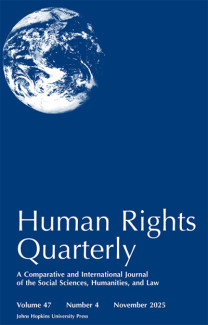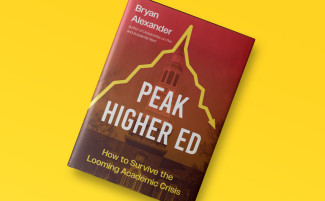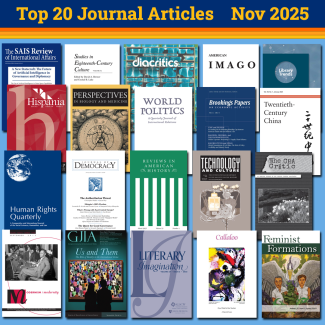
Johns Hopkins UniversityEst. 1876
America’s First Research University
Inspectors for Peace: An Excerpt

by Elisabeth Roehrlich
Since the beginning of Putin’s war in Ukraine in late February, the International Atomic Energy Agency—the world’s nuclear authority—has been trying to ensure the safety and security of Ukraine’s nuclear plants. Meanwhile, it continued its efforts for a revived nuclear deal with Iran. In the following excerpt from the Introduction of her forthcoming book, Inspectors for Peace: A History of the International Atomic Energy Agency (on sale April 5), Elisabeth Roehrlich describes the IAEA’s complex mandate of promoting nuclear technology while aiming to prevent the development of nuclear weapons.
Nuclear Inspectors
Late on the night of 17 May 1974, two international civil servants arrived at their hotel in India after a long trip to get there. The young men, nuclear inspectors for the International Atomic Energy Agency (IAEA), had traveled to South Asia to check on selected nuclear facilities. India had set out to develop a civilian nuclear program beginning in 1948, and foreign countries supported it with sup- plies of material and equipment. The inspectors’ assignment called for them to verify that the Indians were using certain foreign nuclear aid solely for peaceful activities and not directing it toward any military uses. Such on-site inspections in member states were routine tasks for the IAEA, and the offices in Vienna had handed the Indian job to two rather junior inspectors.
During breakfast the morning after the inspectors arrived, they noticed that people at the hotel seemed peculiarly excited. “We saw a lot of smirking around us, because they knew we were from the International Atomic Energy Agency,” recalled one of the two inspectors, Dimitri Perricos, in a conversation more than 40 years later, eager to share his recollections of the day. What was going on? Why were people so interested in the presence of the IAEA officials? The two men asked around until someone showed them a newspaper with explosive front- page news. In the early morning hours, while the two nuclear inspectors slept, the Indian army had tested a nuclear fission device under the Rajasthan desert. The Indian prime minister, Indira Gandhi, claimed that Smiling Buddha, as the government code-named the test, had been a peaceful nuclear explosion (PNE), not a nuclear weapon test. At the time, many states considered PNEs useful, powerful instruments for large-scale industrial and engineering purposes, such as excavation projects and the development of oil and gas fields.
Technically speaking, there was little difference between nuclear explosives for peaceful uses and those for military purposes. This ambiguity made the situation tricky for the inspectors. After all, the international community had charged the IAEA with promoting civilian uses of nuclear technology without furthering its use for military activities. The news about the Indian nuclear test had caught the IAEA inspectors by surprise. “It was a bit embarrassing,” said Perricos in retrospect. Never before had IAEA officials been surprised by a nuclear explosion during an inspection tour. The two men decided to consult their boss, a Yugoslav named Slobodan Nakićenović, the responsible division director within the Department of Safeguards at the IAEA headquarters in Vienna. Making a phone call from India to Austria was a challenge in the mid-1970s. When the inspectors finally got through and were able to ask Nakićenović what to do in light of the unprecedented situation, they were directed to follow the inspection schedule as originally planned.
Today, almost fifty years later, the inspectors’ story, largely forgotten even within the IAEA, raises puzzling questions: How was it possible that the IAEA and its two inspectors on the ground had no clue about the upcoming nuclear test of a member state? Why did the IAEA, which media today like to call the United Nations’ “nuclear watchdog,” not immediately condemn the explosion? Why did the agency’s leadership not initiate further investigations while the inspectors were in India instead of ordering that business proceed as usual? Why did the IAEA, an intergovernmental organization affiliated with the United Nations, continue to offer cooperation on a technology prone to military use?
The Dual Mandate
There is a short answer and a long answer to the above questions. The short answer is that the IAEA had no authority and no instruments that would have allowed it to learn about the Indian test in advance. It also had no power to prevent India from, and no means to penalize it for, testing a nuclear explosive—even if the test had a military origin or purpose. The IAEA was bound by international treaties to fulfill tasks that its member states authorized it to perform. In the case of India, only a few specified items among the foreign nuclear supplies it received fell under IAEA control. The starting material for the plutonium used in the Smiling Buddha test, irradiated uranium fuel, had come from the CIRUS reactor provided by Canada. The United States had supplied the moderator for the reactor, heavy water, on the condition that India use it exclusively for peaceful nuclear activities. Despite the reactor’s foreign origin, the involved states had not placed it under IAEA safeguards. Moreover, India, though an IAEA member, had not signed the Treaty on the Non-Proliferation of Nuclear Weapons (NPT) of 1968, for which the IAEA held authority to verify adherence. The treaty was conceived as an international effort to freeze the number of existing nuclear weapon states, and all the non-nuclear weapon states that signed the treaty committed themselves to forgoing the manufacture or acquisition of nuclear weapons or any other nuclear explosives. Smiling Buddha presented a problem for the IAEA, but it had no authority in regard to it.
The longer and less technical answer to the questions about the inspectors’ powerlessness in India goes to the heart of Inspectors for Peace, which aims to unravel the IAEA’s seeming paradox of sharing nuclear materials, technology, and knowledge while aiming to deter nuclear weapon programs. This paradox has characterized the agency’s mission since its inception. The IAEA’s “dual mandate” of technological promotion and inhibition is enshrined in the first two articles of its statute. In the words of the agency’s legal foundation, drafted between 1954 and 1956, the IAEA seeks “to accelerate and enlarge the contribution of atomic energy to peace, health and prosperity throughout the world.” At the same time, and “so far as it is able,” the agency has the task of ensuring “that assistance provided by it or at its request or under its supervision or control is not used in such a way as to further any military purpose.” The example of the Indian test, and the uneasy global reactions to it, show that reality was and is more complicated. Governments around the world were worried about Smiling Buddha precisely because they did not believe in the ability to strictly separate civilian and military nuclear technologies, especially when it came to an explosive nuclear device.
In recent years, political scientists have increasingly warned of the risks involved in nuclear technical cooperation and knowledge exchange. Based on quantitative studies, Robert Brown and Jeffrey Kaplow concluded that states benefiting from nuclear fuel cycle–related technical assistance through the IAEA “are more likely to engage in nuclear weapons programs,” which “is bad news for international nonproliferation efforts.” Contrary to what the literature might suggest, this is not a new concern. There have always been warnings about the dangers inherent in the IAEA’s dual mandate, and the connections between civilian and military nuclear technology have been well understood from the outset. As the nonproliferation expert Leonard Weiss aptly wrote, “Put simply, spreading nuclear technology spreads the ability (in whole or in part) to make nuclear weapons.” Technical cooperation on nuclear matters can result in providing states with some of the equipment and materials necessary for a military nuclear program or with relevant knowledge and crucial practical experience in handling nuclear technologies applicable to nuclear weaponry. In this regard, critics have described the IAEA’s dual mandate as a “dangerous schizophrenia.”
In short, obvious facts point to the risks of the IAEA’s agenda: the spread of nuclear technology and know-how bears the risk of leading to more nuclear weapon states, and the IAEA’s power to prevent states from developing military nuclear capabilities is limited.
Inspectors for Peace aims to understand the historical evolution of the IAEA’s paradoxical dual mandate, from the hopes and expectations that motivated the agency’s founders to the organization’s inherent weaknesses and failures. The IAEA’s catch-22 of nuclear sharing and denial originated in its founders’ expectation, or at least their hope, that the atom’s peaceful and military uses could be kept apart, recognizing that the uncontrolled spread of nuclear weapons was bad but the distribution of nuclear applications in medicine, agriculture, and industry could benefit humanity. Like other international organizations in the UN system, the IAEA has a technical assistance mandate. Nuclear safeguards have been developed to make sure that such technical assistance is used only for civilian projects, but in the various IAEA publications concerning safeguards objectives and approaches, the term safeguards is never clearly defined. In simple language, “safeguards” encompasses a number of different verification methods, ranging from on-site inspections of member states to containment of nuclear material to remote monitoring of facilities. Throughout the IAEA’s history, the relationship between, and often the opposing nature of, the facilitating and inhibiting aspects of its work have been at the center of political debate among member states.
US president Dwight Eisenhower proposed the establishment of an international atomic energy agency in December 1953, presenting the idea to the General Assembly of the United Nations in his now famous “Atoms for Peace” speech. In an act of unprecedented collaboration between the rival Cold War superpowers, the Soviet Union and the United States followed up on Eisenhower’s concept. Thus the IAEA was born in 1957 amid the optimism and pessimism that simultaneously characterized the post–World War II era and the dawn of the nuclear age. After the United States dropped atomic bombs on the Japanese cities of Hiroshima and Nagasaki in early August 1945, killing more than 200,000 people, numerous politicians and scientists called for the establishment of an international regulatory body to rein in use of the atom’s devastating power. Until the mid- 1950s, uranium, the prime raw material for this new form of energy generation, appeared to be scarce, and many believed that using the rare element for civilian purposes would reduce its availability for weapon programs. The postcolo nial states hoped that the new technology would spur their industrial and scientific progress. According to 1950s logic, a truly modern state had to master the atom. Transcending Cold War boundaries, the optimism surrounding nuclear technology united the East, West, and Global South. The IAEA’s founders were confident that applying nuclear technologies to agriculture, medicine, and energy generation would help solve some of the world’s most pressing problems, among them famine, water and energy shortages, and deadly diseases.
Still today, the IAEA trains scientists from developing countries, sets standards in nuclear safety, security, and diagnostic radiology, assists member states in developing nuclear power programs, and promotes civilian nuclear applications and science in a variety of fields, ranging from food preservation to cancer research. Most of the agency’s achievements in civilian nuclear applications, however, such as the eradication of the tsetse fly in Zanzibar using radiation techniques in the mid-1990s, are less well-known than the activities of the agency’s nuclear inspectorate. To understand the origins, transformations, and contradictions of the IAEA’s dual mandate, Inspectors for Peace looks at key moments in the agency’s history, especially those when the relationship between promotion and restriction became the subject of heated political debate in the agency’s policy-making organs.
Why did the IAEA, an international organization with almost global membership, defend its counterintuitive and risky mandate of sharing nuclear knowledge and technology while hoping to deter nuclear weapon programs? Because, it is argued here, what appears to be the IAEA’s greatest weakness has actually contributed to its success: While the promotional agenda of the IAEA bore risks, it also allowed the agency to facilitate diplomats and national experts coming together at the same table in pursuit of shared missions. In times of crises, the IAEA was a place where scientists from different states continued to work with each other and where governments could pursue diplomatic solutions in an international institutional setting. In 1994, North Korea withdrew from the IAEA and in 2009 expelled the last inspectors working there, leaving the agency with no means and no mandate to document its nuclear activities, thus depriving the international community of valuable insights into North Korea’s nuclear activities. In order to keep states participating in the safeguards regime, the agency needs to offer them tangible benefits. This is why, despite nonproliferation concerns, technical cooperation remains vital for the IAEA’s legitimacy and broad acceptance.
Common sense would suggest that an international organization with contradictory missions and domination by two opposing powers is doomed to fail. In reality, however, the IAEA thrived in such an environment and then survived a major rupture in the international order: the end of the Cold War followed by the dissolution of the Soviet Union in 1991. Judging the IAEA and its dual mandate solely by looking at one dimension of the proliferation problem—technical assistance sometimes helping the development of secret nuclear weapon programs—is too simple. Given this, Inspectors for Peace instead explains why, despite early awareness of the involved risks, the IAEA could not give up civilian nuclear cooperation to prioritize nuclear nonproliferation.




